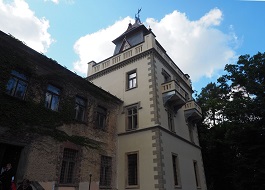
In the autumn, the Zámeček Memorial in Pardubice is expected to open to the public
 |
"Everything depends on how successfully we can create the necessary climatic conditions for the individual exhibits. The construction part will be completed in mid-summer, then the exhibition will be outfitted," Rychtecký stated.
The new building must maintain a stable temperature and humidity. Optimal conditions can sometimes be established within 14 days, but it may also take two months. Some of the exhibits will be loaned by the East Bohemian Museum, which will also install them.
The underground space, being created according to the design by architects Jan Žalský and Vít Podráský in collaboration with historian Vojtěch Kyncl, will give the memorial a completely new form. The exhibition will include not only displayed documents and objects but also an interactive section. The spoken word, such as films, is provided in collaboration with historian Kyncl by actors from the East Bohemian Theater.
During the reconstruction, the original rampart, where executions were carried out in 1942, will be uncovered, and after remodeling, it will become part of the memorial. Unlike in the past, it will be accessible year-round. The entrance will be from Průmyslová Street, where a parking lot will be created. The dominant feature of the national cultural monument will remain the current memorial.
The memorial stands on the site of the former training shooting range of the backup police regiment Böhmen, which the Nazis converted into a Gestapo execution site in the summer of 1942. From June 3 to July 9, 1942, 194 Czech patriots were executed here, their bodies cremated and ashes scattered into the Elbe River. In 1949, a memorial was established at the site of the executions. The current renovation will cost approximately 40 million crowns, with more than 21 million crowns being obtained from European grants.
The English translation is powered by AI tool. Switch to Czech to view the original text source.
Related articles
0
14.12.2022 | By purchasing commemorative coins, people can support the renovation of the Château in Pardubice
0
13.01.2022 | Repairs of the Larisch Villa have so far cost around 50 million CZK, and they are about halfway done
0
25.10.2021 | After long renovations, the Memorial Zámeček with a new exhibition will open in Pardubice
0
27.11.2020 | The Zámeček Memorial in Pardubice is likely to open in September 2021
0
09.11.2020 | The modernization of the Memorial Zámeček in Pardubice is halfway through
0
10.09.2020 | On the weekend, people will be able to view the Larisch Villa for the first time
0
08.04.2020 | Pardubice will begin the reconstruction of the Memorial Zámeček this week
0
24.02.2020 | Pardubice selected a construction company for the Memorial Zámeček
0
16.05.2018 | The Friends of Pardubice Club do not like the modification of the Zámeček Memorial
0
03.10.2017 | The legionnaires will receive money from the city for the restoration of Larisch's villa
0
27.01.2017 | Pardubice supports the modernization of the Memorial Zámeček











